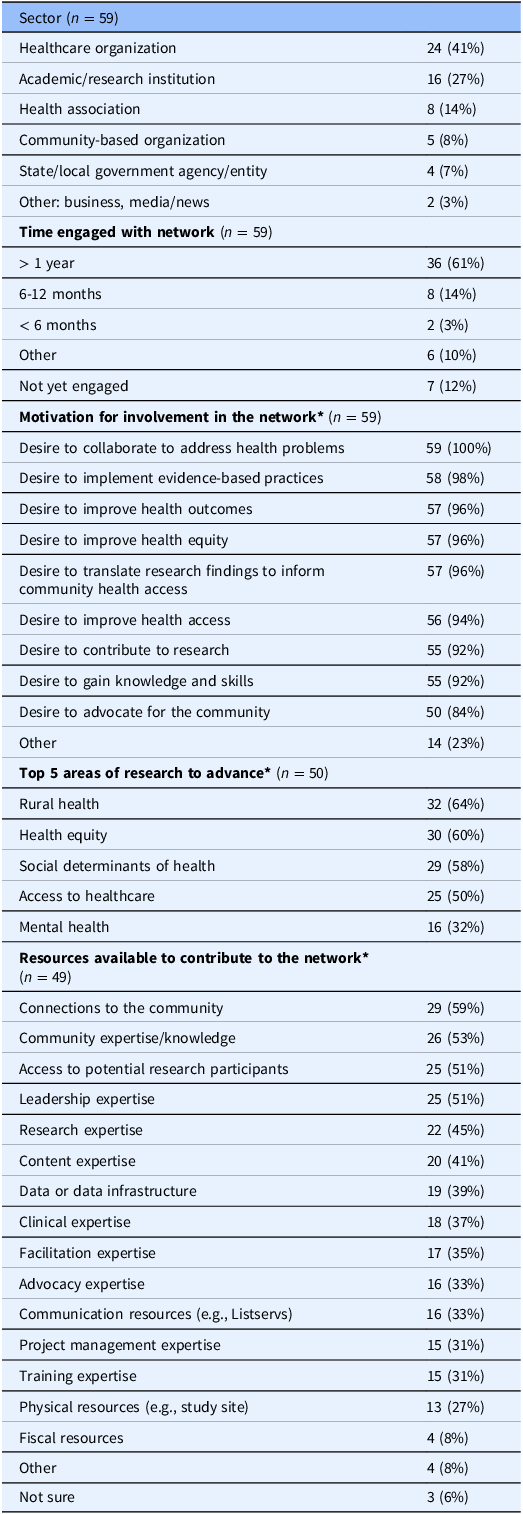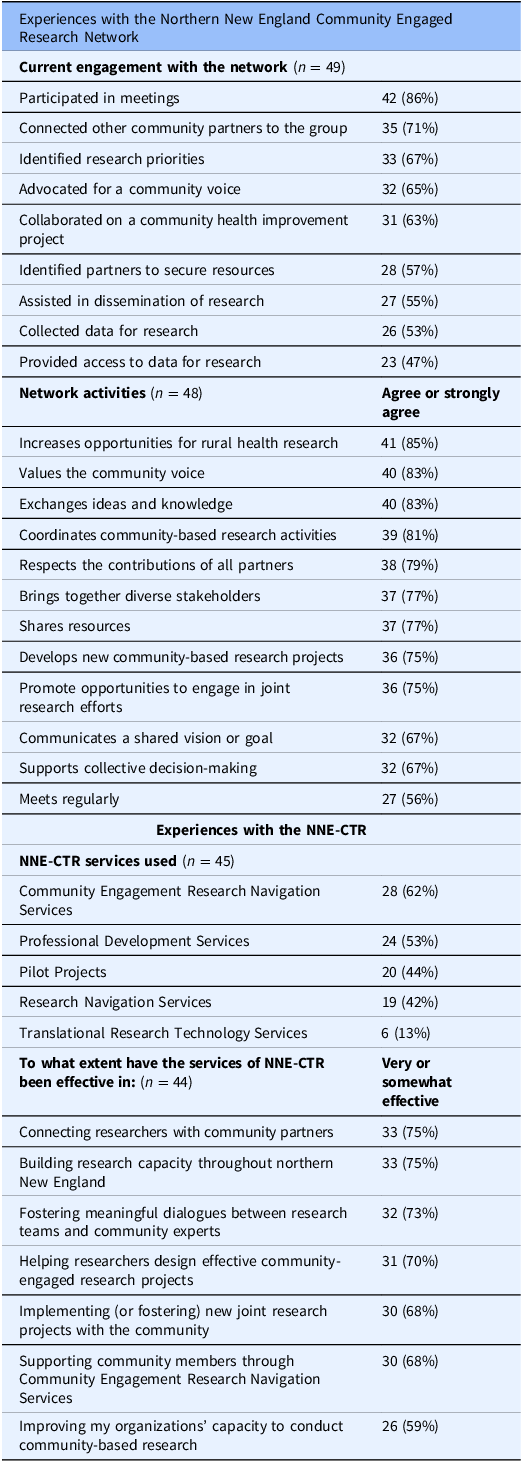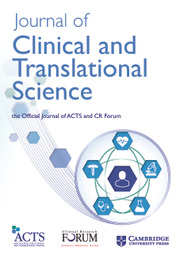Introduction
As part of the National Institute for General Medical Sciences’ Clinical and Translational Research Network (CTR-N) Award program, the Northern New England Clinical and Translational Research Network (NNE-CTR) is a multi-state regional initiative that engages academic institutions, healthcare organizations, public health agencies, and local community-based organizations and stakeholders. The NNE-CTR’s Community Engagement and Outreach (CEO) Core serves as the bridge connecting a wide network of partners with the goal of fostering participatory research opportunities that support ongoing bi-directional engagement between communities and investigators.
Efforts to evaluate community-level research partnerships in other clinical and translational research networks have used several approaches including publication data, administrative data, survey data, and network science. For example, some initiatives have used co-authorship analysis to measure collaboration within research networks [Reference Campbell, Ogunsanya and Holmes1,Reference Yu, Van and Patel2] or examined community-engaged research activities based on attendance data from a collaborative research project[Reference Vasquez, Chatterjee and Khalida3]. Social network analysis and mapping have also been used in combination with bibliometric analyses [Reference Vasquez, Chatterjee and Khalida3,Reference Yu, Patel, Carnegie and Dave4]. Additionally, research networks have created surveys specific to their community-engaged efforts to measure collaboration [Reference Eder, Evans and Funes5]. Other published scales, surveys, and tools exist to measure collaboration among health coalitions and community partnerships; however, reviews have noted a need for reported validity and reliability for many of these tools [Reference Tigges, Miller and Dudding6,Reference Granner and Sharpe7].
Expanding on previous efforts, the NNE-CTR’s evaluation team and CEO Core decided to conduct a social network analysis of the NNE-Community Engaged Research Network. This type of analysis was selected to capture and visualize the relationships within the network. It provides a helpful understanding of how the network functions, as well as highlighting strong relationships and key players. Social network analysis is also valuable in uncovering areas where connections are missing or could be enhanced. These insights are especially useful to an expanding network, like the NNE-Community Engaged Research Network, and will help guide the CEO Core’s engagement efforts in the coming years.
The resource used for the NNE-Community Engaged Research Network’s social analysis was the PARTNER (Platform to Analyze, Record, and Track Networks to Enhance Relationships) CPRM (Community Partner Relationship Management) Platform. This resource was selected because it includes a validated survey based on network science, as well as analytic and mapping features, to track collaborations over time [Reference Varda, Chandra and Stern8,Reference Varda and Sprong9]. A key feature of the survey is the computation of network trust and value scores, along with user-friendly survey tools and mapping software to visualize network characteristics. It has been used since 2008 to analyze community-level partnerships in many different sectors [Reference Kosa, Coelho and Friedman-Burley10–Reference McCullough, Eisen-Cohen and Salas16], and it is a potentially useful tool for evaluating characteristics of community-engaged CTR initiatives over time to assess changes in the strength, activity, and perceived levels of trust and value among participants.
The PARTNER CPRM platform has the ability to conduct a thorough social network analysis while also incorporating more traditional survey questions. The evaluation team’s aim for using this tool is to support its evaluation of how well the CEO Core is strengthening community-level research partnerships in years 1, 3, and 5 of its grant cycle. To gauge this progress, 4 overarching questions are asked:
-
1. What are the characteristics of community partners engaged in the NNE-Community Engaged Research Network?
-
2. What are the activities of the NNE-Community Engaged Research Network?
-
3. How do community partners engage with and view NNE-CTR services?
-
4. What relationships exist within the NNE-Community Engaged Research Network?
As the survey is repeated in future years, the PARTNER tool will enable the NNE-CTR evaluation team and CEO Core to visualize and track how the NNE-Community Engaged Research Network’s members develop relationships, shift in characteristics, engage in activities, and collaborate with NNE-CTR services.
Methods
PARTNER survey
The PARTNER CPRM platform contains the standard PARTNER survey with 19 questions. The survey includes 8 validated items measuring trust and value, and 11 modifiable questions focused on the characteristics of members and the network, as well as members’ perceptions of the network’s goals and progress. PARTNER survey templates are available for different types of networks and include notes about allowable modifications, as well as optional additional questions [17], so that networks can customize the items based on their research or evaluation questions.
The evaluation team worked in collaboration with the CEO Core to revise the modifiable survey items. (Note that the trust and value survey items were not altered in order to maintain their validity.) For example, many of the sample questions were in a “Check all that apply” format. However, the evaluation team omitted this response option format in favor of matrix questions. The team wanted to be able to distinguish between items not checked because they were missing or because the response was no. Other changes to the sample survey items included adjusting the wording of the questions that focused on the characteristics of members and the network (and their response options) so they were more appropriate for a network focused on community engaged research.
The final NNE-Community Engaged Research Network PARTNER survey had 26 items, including the 8 validated relational questions about trust and value, 4 questions about general strategies to facilitate community engagement, 2 items with open-ended responses, 4 questions about organizational characteristics, and 8 items assessing network opinions and engagement.
Participants
To determine who was eligible for the survey, the CEO Core drafted a list of existing and potential members of the NNE-Community Engaged Research Network. In developing this list, the CEO Core used two public health frameworks [18,Reference DeSalvo, Wang, Harris, Auerbach, Koo and O’Carroll19]. Using these broader organizing principles served as a starting point and aspirational framework for network growth and expansion. Members represented various academic/research institutions, community-based organizations, health associations, healthcare organizations, and state or local government entities. In all, 87 members were based in Vermont and 69 members in Maine. An additional 3 members were in New Hampshire, and 1 was from Massachusetts.
Of the 160 total members, the survey was only sent to actively engaged members who had a history of collaboration with the CEO Core, rather than new partners. While selecting a subsample of the larger network population introduced a selection bias, the CEO Core decided it was important to consider their relationships with organizations. It was preferable for the team to hold off on administering surveys to organizations with whom they were still getting to know.
Ultimately, the CEO Core selected 76 members (29 from Maine, 46 from Vermont, and 1 from New Hampshire) who would receive the survey. However, all 160 total members were listed as response options for the relational questions about organizations with whom respondents have an established relationship.
Administration
The survey was sent via email through the PARTNER platform in April 2023. It remained open for 4 weeks. To increase the response rate, NNE-CTR leadership and CEO Core staff conducted personal outreach to potential respondents via email. Some of these follow-up messages included updates about the response rate and early, anonymized social network maps to generate interest.
Results
Of the 76 organizations invited to participate, 59 took part in the survey for a response rate of 77.6%. As shown in Table 1, the majority of respondents (61%) have been involved in the NNE-Community Engaged Research Network for more than one year. Every respondent agreed they are motivated to be involved in the network because of a desire to collaborate to address health problems.
Table 1. Northern New England Community Engaged Research Network Respondents (n = 59)

* Respondents could choose more than one response for these survey items.
The top 5 areas of research that respondents hope to advance through the NNE-Community Engaged Research Network were rural health, health equity, social determinants of health, access to healthcare, and mental health. When asked which resources they have or could contribute to the network, over half of respondents reported being able to contribute connections to their community (59%), knowledge of their community (53%), access to potential research participants (51%), and leadership expertise (51%).
Respondents’ experiences with both the NNE-Community Engaged Research Network and the NNE-CTR are summarized in Table 2. In terms of how network members have engaged with the network, 86% have participated in meetings, 71% have connected other community partners to the group, and 67% of respondents have collaborated on a research project through the network. Overall, 89% of respondents agreed or strongly agreed that the NNE-Community Engaged Research Network increases opportunities for rural health research. When we queried how members of the NNE-Community Engaged Research Network use NNE-CTR services, over half of respondents reported using community engagement research navigation services (62%) and professional development services (53%). Only 13% of respondents reported having used translational research technology services. Over three-quarters of respondents reported that the NNE-CTR has been very or somewhat effective in building research capacity throughout northern New England (77%).
Table 2. Network and Northern New England Clinical and Translational Research (NNE-CTR) Experiences (n = 59)

Among the 160 organizations the 59 respondents could select as partners, 735 total partnerships were identified. As seen in Figure 1, the network map created in the PARTNER platform shows each organization as a circular node. The partnerships, or ties, identified by survey respondents are represented as lines between the nodes. The number of partners identified by individual respondents ranged from 0 to 71 (mean = 15.6, median = 13). Respondents then answered questions about each partner they identified. Most of these relationships were reported as long-standing, existing relationships (63%). About half of the relationships (51%) were categorized as cooperative or coordinated, which the PARTNER platform considers a sustainable level of intensity.

Figure 1. Northern New England Community Engaged Research Network Map and Trust/Value Scores.
The validated relational metrics of value and trust each contained three indicators which are considered equally important. Value was measured by power and influence, level of involvement, and resource contribution. The NNE-Community Engaged Research Network’s scores for each of these value indicators were below the recommended benchmark of 3.00 for a healthy network, and the overall value score was 2.88. This score indicates a need to better leverage partners’ value within the network.
Trust among identified partners was measured by mission alignment, partner reliability, and openness to discussion. The NNE-Community Engaged Research Network’s scores for each of these trust indicators were above the recommended benchmark of 3.00, and the overall trust score was 3.57, indicating that a high level of trust among network partners already exists.
Respondents answered open-ended questions by describing perceived benefits of the NNE-Community Engaged Research Network. Themes from these responses centered around opportunities for connections, both to organizations and to research projects and expertise. Respondents also shared organizations to include as potential partners in future iterations of the survey.
Discussion
Key findings from this evaluation included strong utilization of resources provided by the NNE-CTR and highly cooperative or coordinated relationships between partners. We also observed high levels of trust but more moderate reported perception of value in the engaged research network. The 2023 PARTNER survey results provided baseline data and visualizations to answer the evaluation team’s 4 research questions. As part of the overall evaluation plan, the survey will be repeated in 2025 and 2027. The goal is to increase the network’s reach and trust and value scores by 10% each time.
The PARTNER survey provides a variety of benefits to the CEO Core’s ongoing work to further strengthen community engagement, partnerships, bi-directional collaboration, and focus on community-identified research priorities. The results provided data to support perceptions of partnership strength, high levels of trust, and levels of engagement. These data allow CEO Core research navigators to focus on specific partners for additional outreach and/or communication.
Data related to elements of the value score provide specific topics of power/influence, level of involvement, and resource contribution for further exploration; this overall value score, less than the desired 3.0, provides a longitudinal focus for efforts in both Maine and Vermont to further strengthen types and intensity of interactions and community partner involvement. The CEO Core has previously observed a large power and cultural differential between academic and community-based organizations. However, progress is being made to engage network partners toward more collaborative engagement.
Research interests identified by respondents help CEO navigators in priority setting by connecting researchers in academic centers to community partners in Maine and Vermont in the identified focus areas. This information additionally supports and connects to other Cores. Overall, PARTNER survey data help the CEO Core build on community engagement and trust to align community and academic priorities, both short and long-term.
The flexibility of the PARTNER survey offered numerous benefits. The NNE-CTR evaluation team customized the modifiable survey items to answer its specific research questions. Through this process, the CEO Core recognized the opportunity to include additional questions unrelated to the research questions. While the CEO Core was excited to gain insights through social network analysis, they also had specific needs to learn more from community partners. Including those questions in the PARTNER survey was an efficient outreach strategy.
There are some important limitations to the survey results. While the trust and value scores offer insights into the strength of the NNE-Community Engaged Research Network, their validity would have been improved without the selection bias introduced by convenience sampling. When the survey is repeated in future years, the evaluation team will be able to examine how the sample of respondents varies and if there are differences in scores by subgroup. Additionally, the findings for the NNE-Community Engaged Research Network are limited to its network and not generalizable.
Conclusions
As clinical and translational research networks increasingly prioritize community-engaged research efforts, using validated tools to measure and track relational attributes among organizations provides insights into relationships. The PARTNER platform is an accessible and adaptable tool that can meet this need.
Acknowledgments
The authors would like to give special thanks to the organizations in the Northern New England Community-Engaged Research Network that completed the PARTNER survey. They would also like to acknowledge Visible Network Labs, the company that developed the PARTNER platform.
Author contributions
Kelly Waters: Project administration, writing – original draft, writing – review & editing; Brenda Joly: Conceptualization, project administration, writing – original draft, writing – review & editing; Carolyn Gray: Conceptualization, project administration, writing-original draft, writing – review & editing; Jan Carney: Project administration, writing – original draft, writing – review & editing; Kathleen Fairfield: Project administration, writing – original draft, writing-review & editing.
Funding statement
This work was supported by the National Institutes of Health, General Medical Sciences IDeA-CTR grant (NNE-CTR) [grant number U54GM115516].
Competing interests
The authors declare none.





